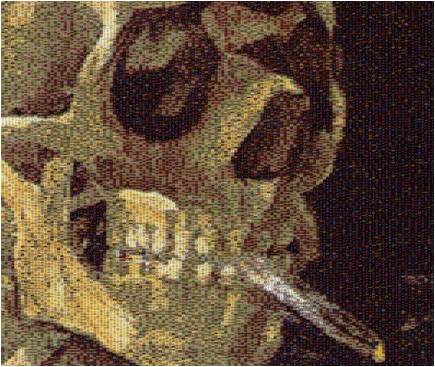Question 1: Look at the following information graphic broken down into a
series of 4 images and answer the following questions:
The original photograph is called “Skull with cigarette, 2007” by Chris
Jordan. It has a caption below the photogtaphs which reads: “Depicts 200,000
packs of cigarettes, equal to the number of Americans who die from cigarette
smoking every six months”. Why didn’t the photographer just present the
information in numbers? Why explain the statistics in graphical form?
First and foremost, information graphics, according to
Lester (2006), is a “visual display” that comprises of data which is either
tabulated or structured into diagrams aided by a text in order to tell a story
to its audience (p. 176). Thus, according to this definition, an information
graph has a narrative. Examples of information are line graphs, bar graphs, pie
charts, etc.
According to
Petterson (1993) “information graphics are informative and may be entertaining
and attention-getters as they aid communication by enabling better
understanding and comprehension; improving readability and increase retention
in a way that they ‘provide the reader with a rapid and easily grasped overall
view of a message and are therefore highly suitable as in introduction to and
summary of a subject (p. 173)”.
In other words,
presenting information just simply in numbers might not be as effective as if
it is presented visually for example in this case graphical form. Explaining
the statistics in graphical form has made us vision a clearer
correlation/relationship between data’s. “Information graphics provide the
reader with a rapid and easily grasped overall view of a message and are
therefore highly suitable as an introduction to and summary of a subject (Petterson
1993, p.173)”. Therefore, graphical form is a simpler version and made us visualise
of what the main clear information in a more efficient way.
In order for the
viewer to understand the statistics or the main important message it is
important to not neglect any information. In this case, referring to the
photograph above it has a caption below the image that reads “Depicts 200,000
packs of cigarettes, equal to the number of Americans who die from cigarette
smoking every six months”. This is the most important message that is trying to
give to the reader of what the photograph is about.
Relating back to the entry post I have written on Week 4 lecture topic on
Visual communication, (Lester, 2006) state “we are becoming a visually
mediated society. For many, understanding of the world is being accomplished,
not through words, but by reading images. Words are easily forgotten, but
pictures stay in our minds.” Therefore by presenting the information just in numbers might not
as effective as it is visually presented.
To sum up, the main answer why didn’t the photographer just present the information
in numbers but chose to explain the statistics in graphical form because it is
much easier to understand rather than to use texts or numbers in much more
complicating way that may confuse us. Thefore it is much more preferable to use
graph to help visualise in trying to explain a piece of information. Nowadays,
with advancement technology graphs are able to present visually-attractive and
attention grabbing through the use of colours, pictures, icons/or shapes to
represent variables.
"Information graphs gives the best of both worlds: it uses words to describe important data and uses pictures to appeal so that readers could remember the information better." - (Chris Woo, Lecture Powerpoint presentation)
References:
Chris, W. H. W. (2010). Analyzing Visual Communication. BA in Professional Communication Reader. Published by University Brunei Darussalam.
"Information graphs gives the best of both worlds: it uses words to describe important data and uses pictures to appeal so that readers could remember the information better." - (Chris Woo, Lecture Powerpoint presentation)
References:
Chris, W. H. W. (2010). Analyzing Visual Communication. BA in Professional Communication Reader. Published by University Brunei Darussalam.
Lester, P.M. (2006). Visual communication: Images with messages (4th ed.). Belmont, CA: Thomson Wadsworth.
Pettersson, R. (1993). Visual information (2nded) (pp. 167-174). New Jersey: Educational Technology Publications.



